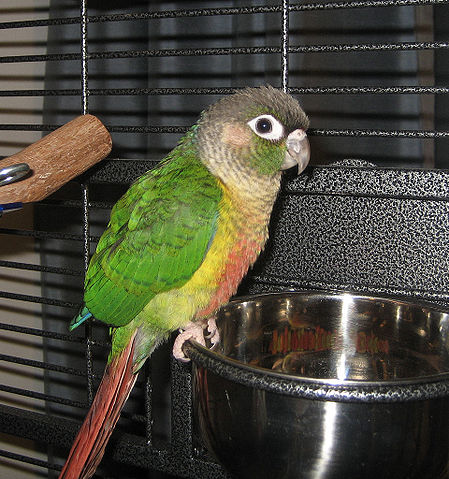The Green Cheek Conure is a small conure and the largest of all Conures and will therefore need a large cage because like all Conures, the Green Cheek Conure needs room to move about his cage.
Your Green Cheek Conure is an active bird and will want to hang from the cage bars, climb, hop from perch to perch, and even lie on the bottom of the cage and play with his feet.
Like many Conures, the Green Cheek Conure enjoys bathing and will require a daily bath. This can be accomplished by misting them, taking them into the shower, or if they’re self-sufficient bathers then you can offer a dish of water for them to splash around in. The Green Cheek Conure is also a good flyer and will want to be exercised daily.
Take care to make flying inside the home a safe exercise. Remove toxic plants, turn off ceiling fans, make sure that nothing is cooking on the stove, and make sure that all doors and windows are closed. Never leave your Green Cheek Conure unattended.

To keep your Green Cheek occupied and not destroy your home, offer your Green Cheek Conure a variety of toys. Green Cheeks love to chew, so toys made of softwood are ideal as well as shiny unbreakable objects and toys that make noises. Green Cheeks are natural climbers and acrobats, give them a perch or a climbing branch to help them express this natural tendency.
Providing your Green Cheek lava blocks and grinding perches inside their cage, will help keep their beaks and nails trimmed. If your Green Cheek isn’t doing their job and keeping themselves groomed, you may need to trim their beak and clip their nails.
Green Cheek Conures enjoy plenty of social interaction. Set aside time every day for you and your bird to play and interact. This can be as simple as hanging out together or as detailed as teaching him a new trick. If you plan on spending time with your bird, you can get by with a cage size, of 18″ x 18″ x 24″, with ½” bar spacing.
If you’re unable to spend time with your bird, then a much larger cage is required. Additionally, if you’re unable to spend time with your Green Cheek, consider getting a second Green Cheek or Maroon Bellied to keep them company. Of course, two Conures will need a large cage to move around in.
Conures live significantly less active lives in captivity than in the wild which means a restricted diet will prevent weight gain and illness. This can be easily accomplished by putting your bird on a feeding schedule. Offering treats is a great way to introduce variety and reward your bird for good behavior.
Variety is the spice of life. A Green Cheek Conure diet, as well as their well-being, is significantly benefited by offering a variety of fruits and vegetables. Additionally, Conures are prone to “Conure Bleeding syndrome”, thought to be caused by a lack of Vitamin K. Here are some options to provide variety and nutrients:
- Broccoli,
- Apples without the seeds,
- Grapes,
- Spinach,
- Chickweed,
- Kale
- Dandelions,
- Carrots,
- Corn on the cob,
- Peas,
- Sweet potatoes.
The absolute best way to keep your Green Cheek Conure healthy is to make sure they have plenty of daily stimulation, an appropriate-sized cage, a wide variety of healthy fruits and vegetables, toys to keep them busy, and of course plenty of love and TLC from their owners.
